Spongy Moth (Gypsy Moth)
The Spongy Moth (Lymantria dispar dispar), formerly known as European Gypsy Moth, is a non-native defoliating insect that feeds on a variety of tree species found in southern Ontario. In Brantford and surrounding areas, the Spongy Moth can be problematic in forested areas with oak dominant communities such as Mohawk Park.
Accidentally introduced in North America from Europe and Asia in the 1860s, the Spongy Moth has thrived with limited predators and can be destructive to local ecosystems. The moth is of concern because during the larva stage of the insect, the caterpillar eats the leaves of trees, defoliating them which in turn may make them more susceptible to disease and damage from other insects.
Although the caterpillars feed on a wide range of hardwood and evergreen trees, they show a preference for certain species such as oak, maple, poplar, and willow trees. Every 8 to 12 years when conditions are suitable, significant increases in populations of Spongy Moths occur. These outbreaks can cause large holes in the leaf surfaces or completely defoliate trees and shrubs in large areas. Continued defoliation of trees can lead to their decline and eventual death.
In Ontario, Spongy Moth outbreaks have peaked in 1985, 1991, 2002, 2008, 2020, and 2021. In the Brantford area, there has been patchy defoliation recorded annually since 2018, with significant expansion of the area defoliated in 2020 and 2021. The Ontario Ministry of Northern Development, Mines, Natural Resources and Forestry (NDMNRF) has indicated this is the worst infestation in Ontario in 30 years.
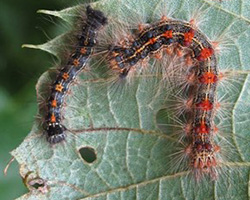
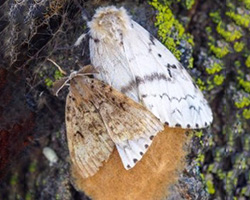
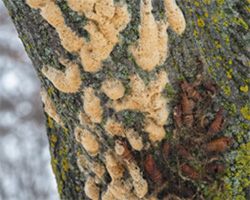
The City’s integrated pest management
Spongy Moth outbreaks may appear suddenly and may continue for several years in any one location. Natural control factors such as disease, parasites, and predators eventually combine to cause a collapse of these outbreaks. Consecutive years of Spongy Moth infestation can cause severe defoliation which can lead to tree mortality.
Intervention may be required to control continued outbreak levels of Spongy Moth in areas with trees that are at risk of mortality if no action is taken. Eradication of the Spongy Moth is not a realistic management objective since it is well established throughout North America.
Several strategies to address the pest population may be necessary. Strategies that are the least harmful to the environment are initiated first. Control measures include the removal of caterpillars, burlap banding, insecticide application, installation of pheromone traps, removal of egg masses (where possible), and in some cases biological controls. For more information, see the Spongy Moth Lifecycle and Control Measures section below.
In the fall, egg mass surveys can be undertaken to assist with anticipating projected Spongy Moth populations, and whether spraying insecticides, biological control measures should be considered as part of an overall management strategy in subsequent years.
| 2021 Egg Mass Survey |
| The Forestry Division has contracted a Forestry consultant who specializes in pest management strategies to conduct intensive surveillance in three parks (Glenhyrst Gardens, Mohawk Park, and Mount Hope Cemetery) and the municipally owned trees along two streets (Summerhayes Crescent and Lakeside Drive). In the late October 2021, the consultant conducted egg mass surveys in these areas and concluded that all the surveyed areas are likely to experience significant defoliation in 2022 if left unmanaged. |
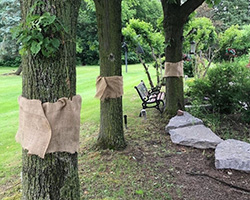
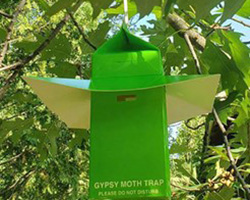
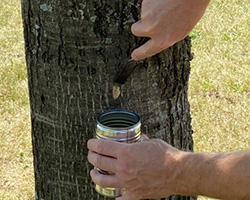
Aerial spray management program
Based on population surveys conducted in 2021, the City of Brantford is expected to face extreme levels of Spongy Moth this year that could result in a significant loss of trees if no action is taken. Therefore, this spring, the City conducted an aerial spray in select areas with a safe and naturally occurring biological insecticide to limit the effects of the Spongy Moth infestation - the first spray on May 24, and the second spray on June 2.
| 2022 public notice of pesticide use for the Spongy Moth | |||||||||||||||||||||
| Read the Public Notice-The City conducts aerial spray application to help control Spongy Moth infestations. | |||||||||||||||||||||
| Spray areas | |||||||||||||||||||||
|
There are five designated spray blocks and a total block size is 55 hectares. These spray areas will be closed temporarily during the spray and reopen immediately after. Closure signs will be posted.
Check each spray block map and the list of adjacent properties (within 100 meter buffer) below. |
|||||||||||||||||||||
| Pesticide being applied | |||||||||||||||||||||
|
The aerial spray will use Foray 48B Biological Insecticide Aqueous Suspension, containing active ingredient Bacillus thuringiensis, subsp. kurstaki (Btk) strain ABTS-351 (PCP# 24977), under the Pest Control Products Act (Canada). Foray 48B (Btk) is approved by Health Canada for aerial use over urban areas. It has been extensively studied by Health Canada and the US Environmental Protection Agency (EPA). Research shows that Btk used in aerial spray programs has no negative environmental or human health effects. Btk is a bacterium which occurs naturally in soil and biodegrades quickly in the environment. Btk produces a protein that is toxic only to the caterpillars of specific insect species. When ingested by susceptible insects (early caterpillar stage of Spongy Moth), the toxic protein molecules break down the walls of the insect’s stomach causing the insect to stop feeding. The insect usually dies within two to five days. Btk does not affect adult moths or butterflies or other beneficial insects such as honeybees, pets, birds, fish, or mammals. For Btk toxins to be activated, the alkaline conditions that exist only in certain insects’ digestive systems must be present. The acidic conditions in the stomachs of humans and animals do not activate Btk toxins, which is why the pesticide is not toxic to humans and animals. There have been no documented cases involving toxicity or endocrine disruption potential to humans or other mammals over the many years of use in Canada and around the world. Studies have shown that even if Btk spores are ingested or inhaled, they are eliminated without any adverse health effects. The fact that Btk is a naturally-occurring, widely-distributed organism in the environment means that the average person would have multiple exposures to this biological agent throughout their lifetime, even if they never came in contact with a formulated product. Btk has been used in many countries over the last 30 years without health impacts to individuals on medications or vulnerable populations. Most of other municipalities in Ontario – Toronto, Mississauga, Oakville, Hamilton, and London – will be conducting an aerial spray program with this same product this spring as well. |
|||||||||||||||||||||
| Preparing for aerial spray | |||||||||||||||||||||
|
No special precautions are required for residents in the spray zone. Individuals who have concerns should take reasonable precautions to avoid exposure during a spray program in the same way they would avoid pollen or other airborne materials during days when air quality advisories are issued. If people wish to avoid exposure, they can consider:
Foray 48B (Btk) aerial spraying is not expected to have adverse effects on vulnerable populations including: children with asthma, people with weakened immune systems, pregnant women, or the elderly. Infrequently there may be some residents who are more sensitive and may experience skin, eye or respiratory irritation. If you experience an adverse reaction or worsening medical condition, speak to your physician or, in an emergency, call 9-1-1. |
|||||||||||||||||||||
| Aerial spray application | |||||||||||||||||||||
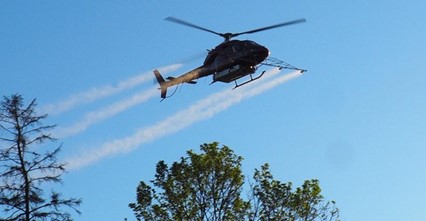 Organized and coordinated by the City, the aerial spray follows provincial and federal regulations, guidelines and best practices. During an aerial spray, a two-engine helicopter with an ultra-low volume spray system will fly at low altitudes, about 15 to 30 metres, above the tree canopy. The product is directly applied to tree foliage as the caterpillars must feed on the treated leaves for the insecticide to be effective. Residents can expect high audible levels as the helicopter completes its once-over path. Organized and coordinated by the City, the aerial spray follows provincial and federal regulations, guidelines and best practices. During an aerial spray, a two-engine helicopter with an ultra-low volume spray system will fly at low altitudes, about 15 to 30 metres, above the tree canopy. The product is directly applied to tree foliage as the caterpillars must feed on the treated leaves for the insecticide to be effective. Residents can expect high audible levels as the helicopter completes its once-over path. |
|||||||||||||||||||||
| Aerial spray schedule | |||||||||||||||||||||
|
The best time to apply Foray 48B Btk is in mid-May when caterpillars are small and feeding. Once the leaves are a certain size, the caterpillars have reached almost 90 per cent emergence and the caterpillars begin feeding, the spray window can be narrowed. Once these factors are met, weather conditions are monitored. Pesticide application is highly weather-dependent. Ideal application conditions consist of: calm winds (1-16 km/h), high humidity (>40%), temperatures between 2 and 25 degrees Celsius, and no precipitation within the spray window dates and ideally not for 24 to 48 hours after application. Aerial spraying takes place on two days. In 2022, the first spray has been completed on May 24, and the second spray on June 2. |
Spongy Moth lifecycle and control measures
The Spongy Moth’s lifecycle is important in managing its impact. There are four main stages of the Spongy Moth lifecycle.

Egg
- This dormant and over-wintering stage lasts eight months from late August to early May.
- Egg masses are fuzzy and tan in color. They range in size from 2-8 cm long and can contain between 100-1000 eggs.
- Eggs are usually laid in dark, sheltered areas such as in bark crevices, on the underside of branches, or in leaf litter, although they can be also be found on a wide variety of surfaces such as rocks, buildings, lawn furniture, and automobiles.
- WHAT TO DO? You can remove egg masses as you see them, before hatching occurs in the spring.
| Egg mass removal |
|
Step-by-step instructions
Note: egg masses can be located high up in trees. Care needs to be taken if trying to access anything aloft, especially if using ladders. Some private tree care companies can be hired to provide this service at heights. |
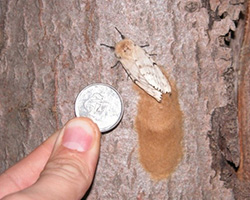
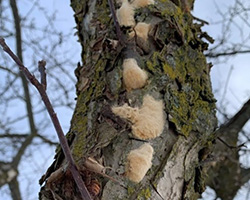
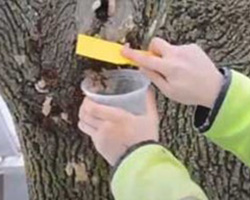
Caterpillar
- This is the tree damaging stage and can last about 40 days, from early May to mid-July.
- A single caterpillar can eat an average of one square meter of foliage. They continue to feed, moult, and feed until they are about 6-7cm long. The caterpillars climb up to the tree canopy and also travel to a nearby tree through a method called “ballooning”, where they dangle from long silken threads at the end of branches and are carried away by the breeze.
- The caterpillars of the Spongy Moth are dark and hairy. They have five blue dot pairs and six red dot pairs on their back. They go through 4-5 moulting stages where they shed their skin and each time, they get bigger.
- Once they’ve finished feeding (around mid July), they seek shelter to cocoon.
- WHAT TO DO? Handpicking or Burlap banding can be effective.
| Handpicking |
|
| Burlap banding |
|
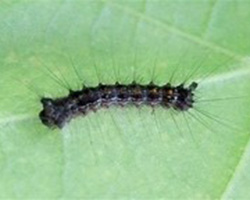
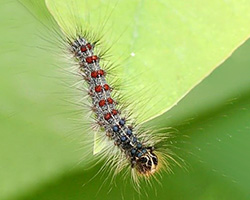
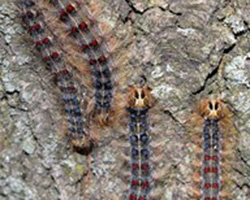
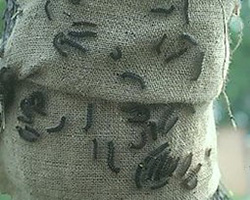
Pupa
- This transformation stage lasts 10-14 days, from mid July to early August.
- After the adult moth emerges, it leaves the empty cocoon behind. The female cocoon is larger than the male cocoon.
- The cocoon can be found on a variety of surfaces including trees, rocks, houses, boats, trailers, fences, picnic tables, etc.
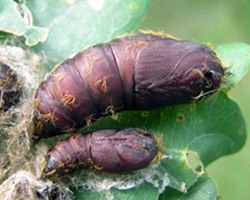
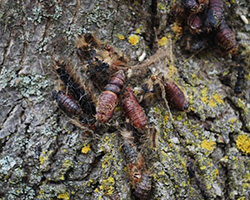
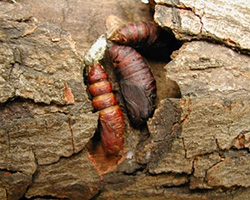
Moth
- This reproductive stage lasts about 10 days, from late July to mid August.
- An adult Spongy Moth’s only function is to reproduce. Unlike other species of butterflies and moths, adult Spongy Moths do not eat anything.
- The female is larger than the male and is cream coloured. The female moths cannot fly. Instead, she uses pheromones to attract male moths.
- Male moths are smaller and brown in colour.
- WHAT TO DO? Pheromone traps can be used.
| Pheromone trap |
Step-by-step instructions
|
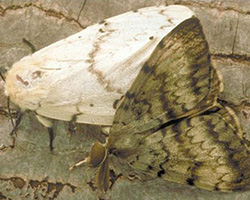

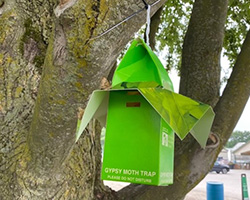
YouTube Video
Frequently asked questions








 Subscribe to this Page
Subscribe to this Page